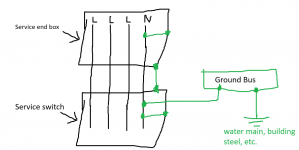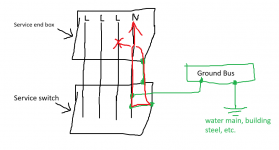If that box is subject to the NEC* then the NEC requires the box to be bonded to the neutral. See 250.92(B)(1).
So, that is what I had understood, that the box would have to be bonded to the neutral service conductor right there in the box, until this thread came up and I reread 250.92.
250.92(A) basically says all the non-current carrying metal parts of the service disconnect and upstream have to be bonded together. Then 250.92(B) gives you various way to do that bonding, of which 250.92(B)(1) is bonding equipment to the grounded service conductor, but that is not the only option.
So say your service point is in a "service end box", and from it you have a regular KO, a length of RMC, and a service disconnect enclosure, again with a regular KO. Your two enclosures and the length of RMC all need to be bonded together per 250.92(A).
The MBJ bonds the service disconnect enclosure to the grounded service conductor, so that takes care of the first of the three items. Two regular locknuts does not suffice to bond the RMC to an enclosure under 250.92(B), so you use a bonding type locknut on the service disconnect end, as per 250.92(B)(4). That takes care of the RMC.
Which leaves just the question of how to bond the service end box. You could bond it directly to the grounded service conductor per 250.92(B)(1), and then just use two regular locknuts on the RMC entry. That method will give you parallel grounded conductor current on the RMC conduit, because the two locknuts, properly installed, will bond the box, just not in the manner required by 250.92(B).
Or you could decide to bond the service end box to the already bonded RMC conduit, via another bonding type locknut as per 250.92(B)(4). That lets you omit any direct connection of the grounded service conductor to the service end box within the service end box itself, avoiding parallel paths for grounded conductor current.
Cheers, Wayne


